

XXII Polish-Czech Seminar
Structural and Ferroelectric Phase Transitions
Hucisko, May 16-20, 2016
Excursions
Excursion A - The Trail of the Eagles' Nests (Szlak Orlich Gniazd), excursion A is planned for 50 participants.
Excursion B - Pieskowa Skała and the Ojców National Park, excursion B is planned for 50 participants.
Excursion A
The Trail of the Eagles' Nests (Szlak Orlich Gniazd)
The Trail of the Eagles' Nests encompasses 25 medieval castles in south-western Poland stretched out between Częstochowa and Kraków. The castles were erected at the behest of the king of Poland Kazimierz the Great (Kazimierz Wielki) to protect 14th century border of Lesser Poland with the province of Silesia, belonging at that time to the Kingdom of Bohemia. They are named the "Eagles' Nests" because most of them are located on large, tall rocks of the Polish Jura featuring many limestone cliffs, monadnocks and valleys.
Nowadays the Trail of the Eagles' Nests is one of the best and most popular tourist trails in Poland. It comprises all 25 castles, is 163 kilometres long and has the bicycle trail with total length of 188 km. During this excursion you will visit three castles located on the Trail of the Eagles' Nests in Ogrodzieniec, Mirów and Bobolice.
Ogrodzieniec Castle is a medieval ruin situated on the highest hill of the Polish Jura, the 515.5 m high Castle Mountain (Góra Zamkowa). Surrounded by three limestone rocks, the castle is perfectly adapted for the surrounding landscape; its walls are integrated with the rocks to form defensive bailey with a narrow aperture serving as an entrance.
The history of Ogrodzieniec castle begins in the early 12th century, during the reign of Bolesław III Wrymouth (Bolesław Krzywousty), when the first stronghold was founded. Soon it was razed to the ground by Tatars in 1241 and the ruins were replaced by a new gothic castle. In 1530–1545 Seweryn Boner, banker of Sigismund I the Old (Zygmunt I Stary), replaced the medieval stronghold with a renaissance castle. Hard times for the castle began in 1587, when it was captured by the army of Maximilian III, the rejected Austrian candidate to the Polish-Lithuanian throne. In 1655, the castle was partly burnt by the Swedish troops and finally, in 1702, burnt down in the fire settled by the Swedish army of Charles XII. After this fire, it has never been rebuilt.
Mirów Castle is another 14th century castle built during the reign of Kazimierz the Great (Kazimierz Wielki). Initially it was a stone watchtower subordinated to the castle in Bobolice. Primitive watchtower was soon extended to a medieval castle. Mirów changed owners multiple times before it was bought by Piotr z Bnina in 1442 and next substantially modernized. The works were continued by the next owners, Myszkowski family, who established there their family seat. A big part of the castle walls was destroyed during Swedish invasion 1655–1660 (Potop szwedzki) and after that the castle fell into ruin. It was finally abandoned in 1787. The ruins of the castle owned by the Lasecki family are under conservation.
Bobolice Castle The castle in Bobolice was built by the king Casimir III the Great (Kazimierz Wielki) and together with Ogrodzieniec and Mirów was a part of the defense system of royal strongholds. Since 1379 the castle was leased by its owner duke Władysław of Opole (Władysław Opolczyk) to a Hungarian Andrzej Schoen. The new owner garrisoned the castle with Germans and Czechs, who robbed neighborhood and conspired with the Teutonic Order (Zakon Krzyżacki). To protect local inhabitants the Polish king Władysław Jagiełło captured Bobolice in 1396 and seized the castle. In 18th century the castle was felling into ruin and was completely devastated in 19th century by treasure hunters. The ruins of the castle were rebuilt in 21st century by the Lasecki family. Now the castle serves as a hotel and conference center.
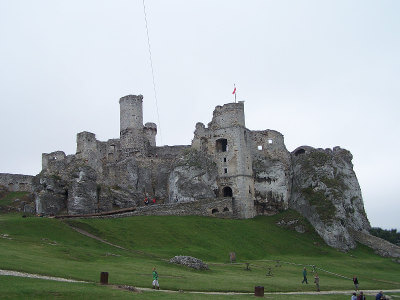
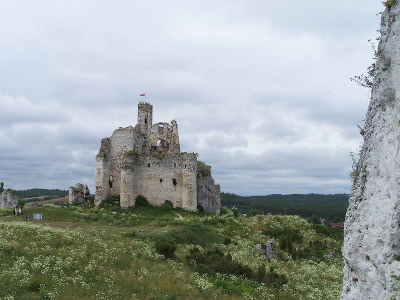
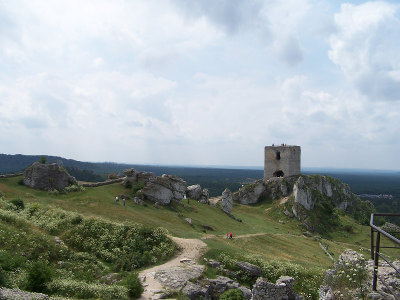
Excursion B
Pieskowa Skała and the Ojców National Park
The castle in Pieskowa Skała (Little Dog's Rock), is one of the 25 fortified medieval castles extending north-west from Kraków to the city of Częstochowa. These castles were erected at the behest of the king of Poland Kazimierz the Great (Kazimierz Wielki) to protect 14th century border of Lesser Poland with the province of Silesia, belonging at that time to the Kingdom of Bohemia. They are located on large, tall rocks of the Polish Jura featuring many limestone cliffs, monadnocks and valleys and named the "Eagles' Nests".
The Trail of the Eagles' Nests is one of the best and most popular tourist attractions in Poland. It comprises the chain of 25 castles, is 163 kilometres long and has the bicycle trail with total length of 188 km.
Pieskowa Skała (Little Dog's Rock), is a limestone cliff with Renaissance castle in the valley of river Prądnik. This stronghold was mentioned for the first time in Latin documents of the Polish king Władysław I the Elbow-high (Władysław Łokietek), as "castrum Peskenstein". The castle was renovated by king Casimir III the Great, and in 1377 it was leased by Polish king Louis I of Hungary to Piotr Szafraniec. The castle was rebuilt in 1542–1544 by Niccolò Castiglione and became a notable example of a defensive Polish Renaissance architecture. In 1640, its owner Michał Zebrzydowski erected a chapel and added on the bastion fortifications with a baroque gate. The castle adjoins the Ojców National Park.
Ojców National Park (Ojcowski Park Narodowy) is a national park in southern part of Polish Jura, approximately 16 kilometers north of Krakow. Established in 1956 and named from its headquarter in the village of Ojców, it is the smallest national park in Poland, with an original area of 14.40 km2 only, expanded later to 21.46 km2. The landscape of Ojców National Park is dominated by karst topography of soluble bedrock and valleys of Prądnik and Saspówka rivers. It contains numerous limestone cliffs, ravines and over 400 caves with the largest of them Łokietek's Cave, which served as a shelter for the king Władysław I the Elbow-high (Władysław Łokietek). The most famous rock formation in Ojców National Park is Hercules' Club (Maczuga Herkulesa), a 25-meter high limestone monadnock. The park is a home for over 5500 species of animals, including 4600 species of insects (1700 of beetles, over 1000 of butterflies) and 135 of birds. There live also beavers, badgers, ermines, and bats which hibernate in the park's caves during winter.
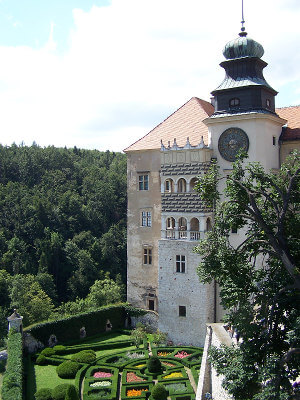
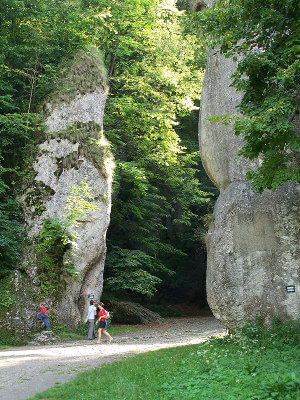
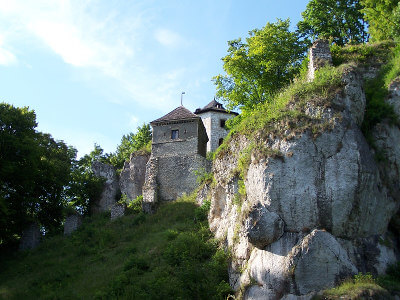
Photos by Bartłomiej Andrzejewski